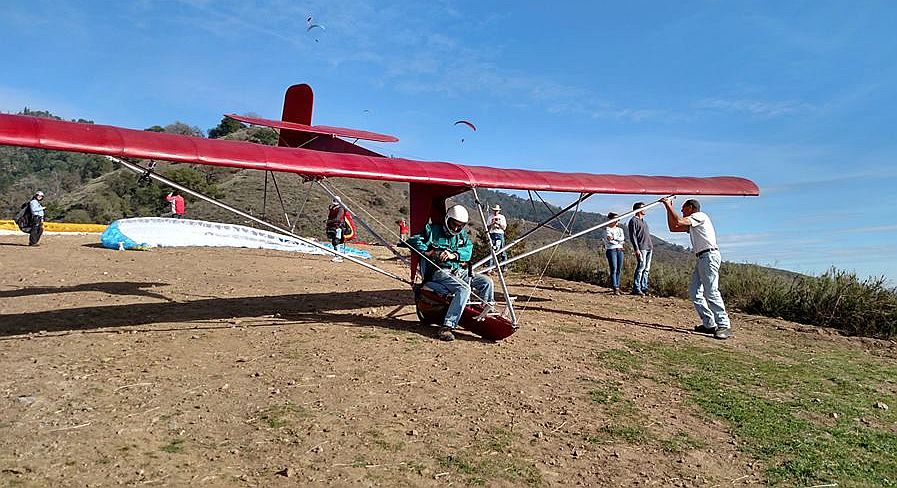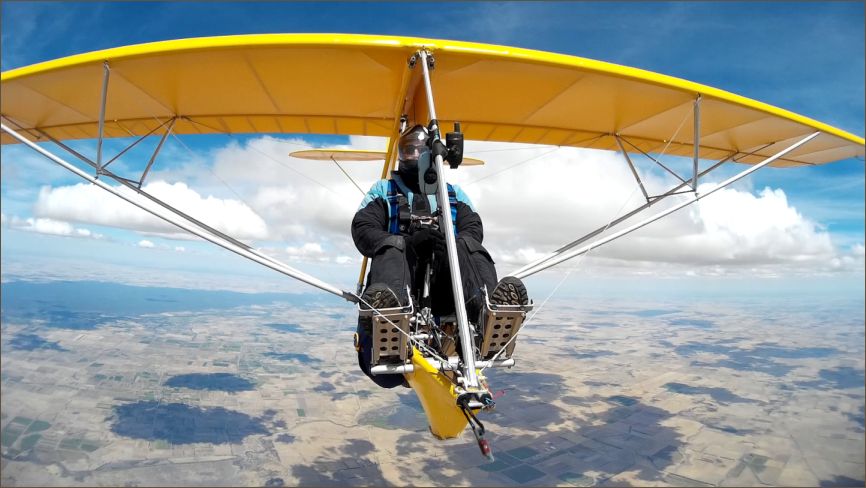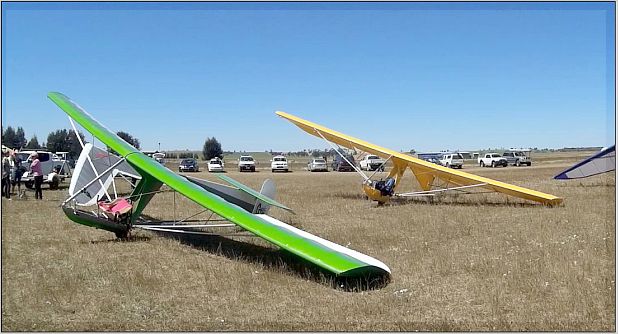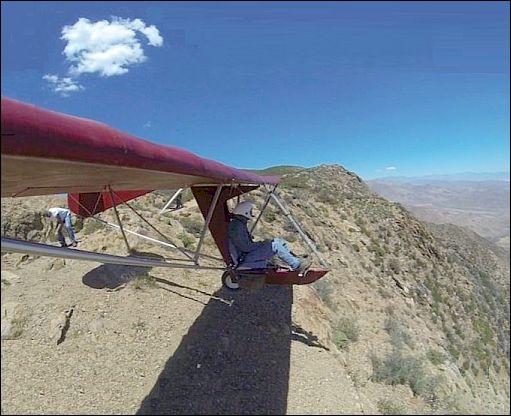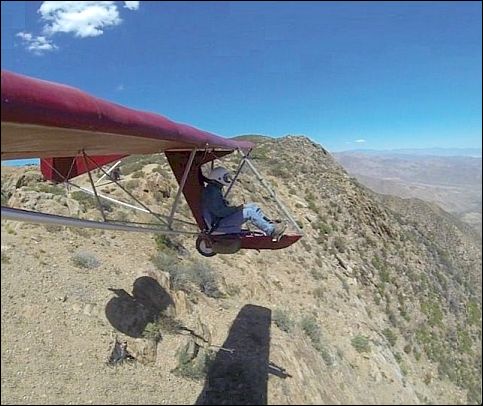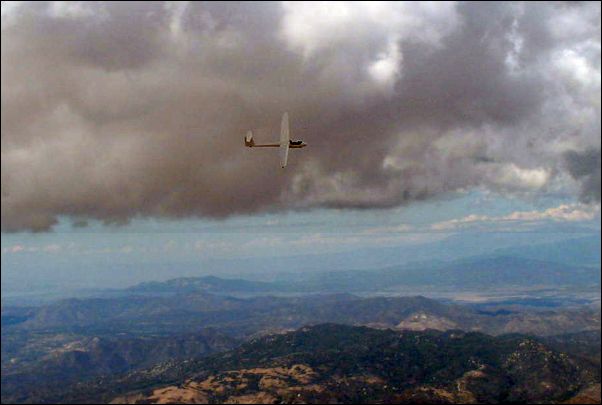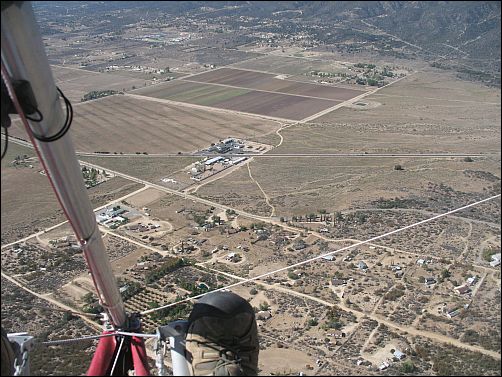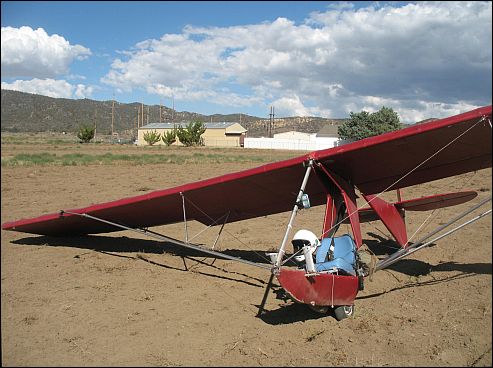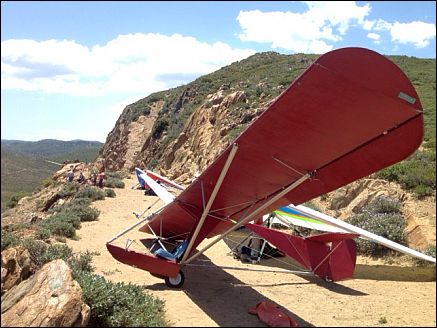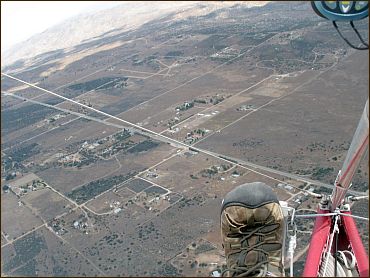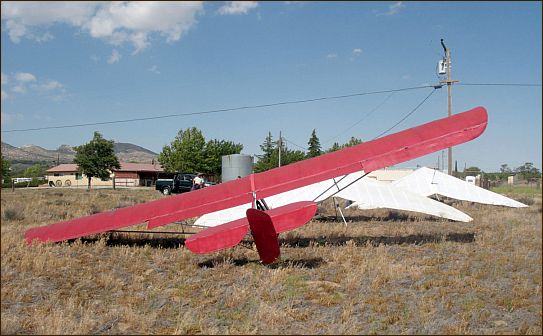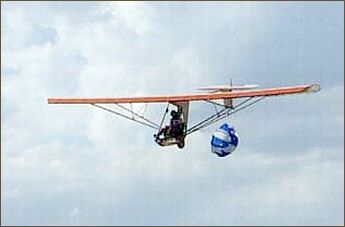by Mike Sandlin ................................ Last edit: March 3, 2019
The
Peruvian Supergoat, another video with the new electric motor, some
climbing this time...
Electro-Pelican,
Full Flight, a sustaining Test Flight with electric motor
The Peruvian Supergoat is back, now with a video of an experimental electric motor! From the Airchair Yahoo page:
Hi Guys,
I don't know how much the glide was extended, but that sure looked like a short takeoff roll!
Electro-Pelican
Test Flight with electric sustaining motor
October
10, 2018....Mihai Forna reports that the Romanian Goat is flying with
good results! Here it is, in both the one wheel version (previous) and
the new two wheel version with spring struts. Mihai writes that
a video may be coming, and a motorized version is in the works.
 |
 |
See
the Airchair Yahoo Group photos for more details. There is also a
brace added between the cabanes to stiffen them under the increased
landing loads encountered with the cable bracing. Mihai came up with
this idea and I think he is right, although I never noticed anything
while flying the Goat 4 cable braced glider.
|
This
is the Turkish Goat, not a recent photo but really
stylish. Notice the arm rest in use, as well as the cool
nose fairing!
|
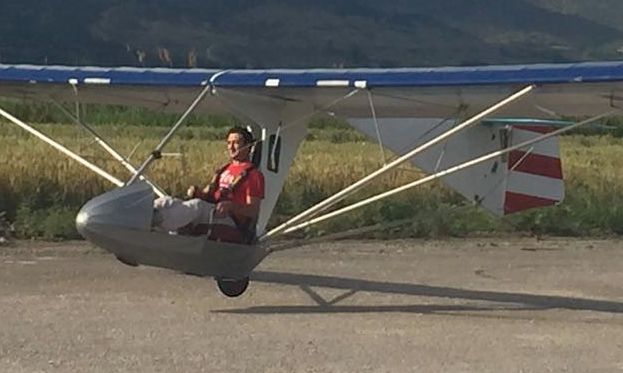 |
___________________________________________________________________________________________________________________________
In this clip the
Turkish Goat flies a complete ground tow, well flown overall. The Hall
wind speed indicator is visible and looks
stable the whole time, I can see the indicator moving smoothly. The yaw string is on the sweep cable, I had trouble reading that
on
my Goat so I mounted it near center line on a short offset from the
nose tube.
As usual, the rudder pedals are twisting in use but are not much of an issue. In flight, but not on the ground, the ailerons are a
little washed out relative to the flap panels, that's ordinary and not a problem. The GoPro lens is not my favorite, it looks like the
Goat has tremendous sweep back, but maybe this is suggestive of the future. I have not seen the belts with a chest buckle before,
this
is something new.
This
is the only Goat with arm rests, a true flying garden chair!
The Goat 2
drawings are back by popular demand (one guy wrote in). See the Airchair
Technical Drawings Page and get the zip
file there. [These old dxf files may be hard to open, try for a bitmap view if necessary using Irfanview with the CAD plug in.]
Here's
a video of a Spanish airchair, a design I have not seen before.
Thanks to "Nest of Dragons" website.
Spanish version of Compact 110
Edgars
Koks and friends are building a Goat in Latvia:
There
are lots of ideas here, some details on water jet cutting of the flat
metal parts (good job, better than my hack saw),
computerized tube drilling, and use of composites, also some superb oblique views of planned assemblies. This is all pretty
fancy, I hope they are willing to let this plane out of the box so it can do some real flying, which means taking some hits and
possibly
breaking things! This is going to be impressive.
...............................................................................................................................................................................................................................
Oz Goat
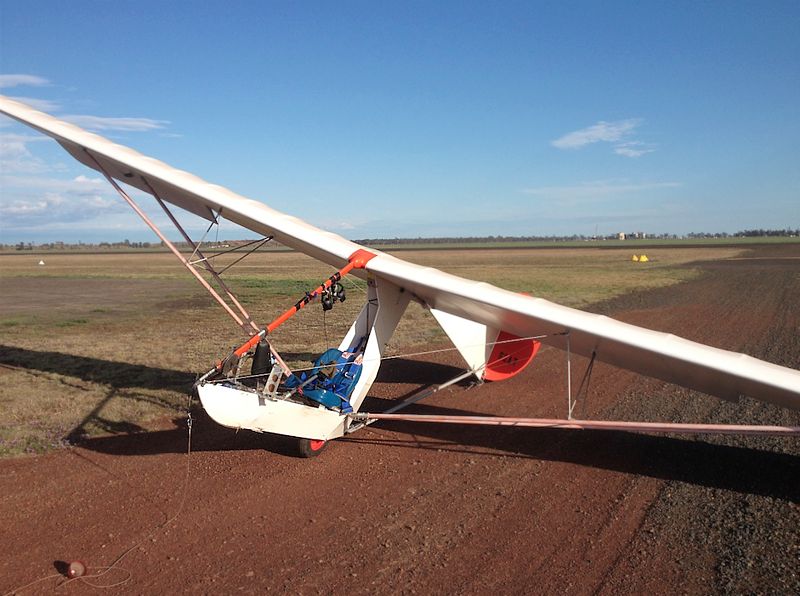
..............................................................................................................................................................................................................................................
|
February 1,
2003....First flight of the Goat! There I go, down the hill
in Goat 1 after a rolling launch, 13 years ago in San Diego,
California. The struts had no fairings, the wheelbarrow
wheel was in use, and the glider weight was 125 pounds. The
fabric was just dope sealed polyester without any silvering,
except for the spray panted rudder. The struts were not
detached for transport, they just rotated up flush to the
bottom of the wing.
This was all carried on the flat padded hang glider rack on the top of my pickup truck. The removable fasteners were the "quickpins", not ordinary bolts, but tapered assembly pins that were retained in flight. Quick assembly by one person and transport on a simple car top rack are still major contributions to practical operation and frequent flying. Development continues all around the world, hopefully in the direction of lighter, simpler, and easier. My judgement is that a dozen years of efforts to enhance performance have resulted in nothing of substance, and the way to fly better in a Goat is just to find a satisfying way to fly it frequently. |
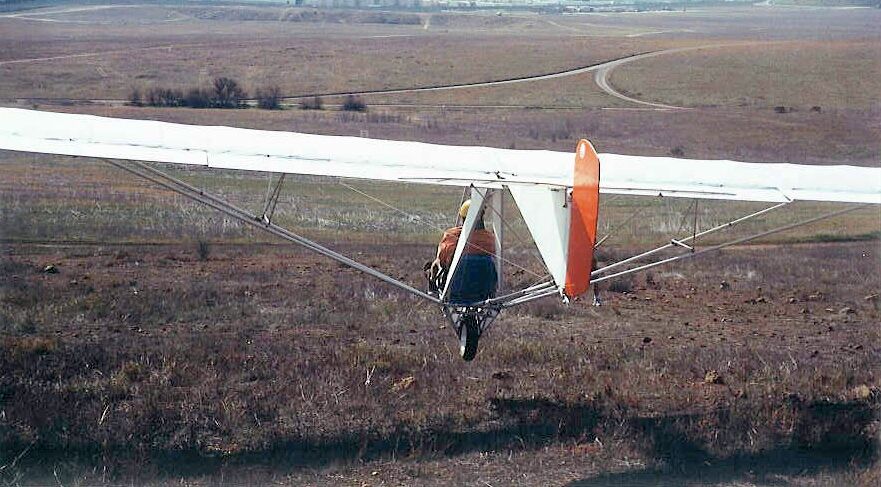 |
Alan Beavis in the Yando Goat, soaring in Australia, made a 102 mile Goat flight from Boort north in December, 2015
(see KMZ file at the Airchair Yahoo Group webpage). From that ground track file I concluded that most of the distance
was covered while circling, which I would not have expected.
From the same start point the Archeopteryx glider has made flights up to 375 miles, and probably didn't circle as much,
since it had a much higher average speed. Although the Archeopteryx has an enclosed pilot and an aerodynamically
much
cleaner airframe,
it may serve to suggest how far we could possibly go with an airchair.
However, I don't think we have to go that way. My new year's wish is that pilots who want high performance will fly an
Archeopteryx
while the Goat is developed in the other direction, becoming a
lighter, simpler airchair that is easy to operate
and frequently flown.
----------------------------------------------------------------------------------------------------------
For a good time, look at lots of Goat
flying videos! Search for "Goat glider -simulator" in the video
category in your browser search engine.
(I had to research how to exclude a
search word, that's the "-simulator" part, to exclude all the Goat
Simulator game videos).
To be sure you can find some of the new
and special videos, here are a few:
Another
video from Alan Beavis in the Yando Goat, spring soaring in
Australia, plus...
More Wedge Tail Eagle Encounters

Goat flying in Turkey
Floyd Fronius on a Red Goat cross country flight in Arizona...beautiful, simple, and long enough to let you play your favorite music:
The Red Goat and a pair of Superfloaters entered a sanctioned hang glider competition in Arizona, introducing Class Four competition in a mix of hang gliders,
rigid
wings, and airchairs. Floyd Fronius in the Goat was the Class Four
winner (first ever)! (Also first ever homebuilt ultralight
glider to win a class victory?) See the video:
Airchairs at the Santa Cruz Flats Race
Goat
Takeoff at SCFR, 2015 My comments: this
looks like a fairly typical aerotow launch (or several edited
together). The tow line is attached at the very front of the nose, in
a stable position clear of all snags.
The wing runner is usually on the upwind wing, on the left in this case. Floyd uses rudder and arm signals to try to start the tow, but the tow pilot seems to be watching the wing runner, which is probably a good idea
since he is the one who can see everything. The runner gives a low wave and the tow pilot takes out the line slack and stops. Then the runner gives the full circle wave that means the line is tight, start the flight.
The glider starts nose down, but gets pulled nose up and has to wait to get enough elevator authority to get the nose back down to level, probably a sign of weak headwind and a slow accelerating tow plane.
There is plenty of beautiful open space out front, so the glider pilot has lots of options if there is a line break.
Floyd
Fronius on the SCFR Takeoff video: "What this shows is bad
technique. This was one of my first aerotows in a long time. You can
see that I start with the stick centered in pitch. The correct
method is shown in the Task 4 video [see above]. Start with the nose
on the ground and the stick fully forward, then bring it back slowly
till it lifts off. Works every time".
.........................................................................................................
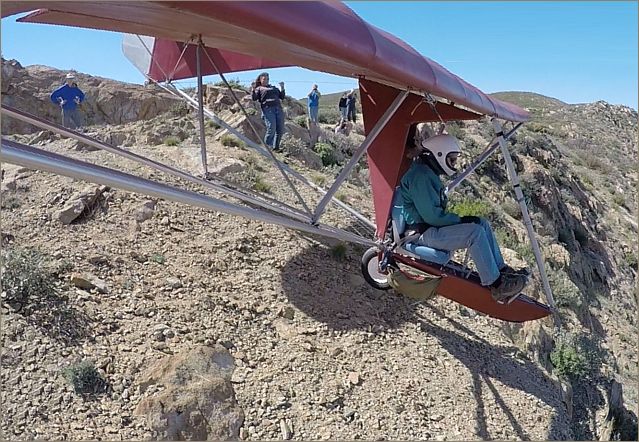
|
Floyd
Fronius in the Red Goat opens his cross country season with
another awesome cliff launch at Mount Laguna (Kwimee Point, in
San Diego County, near Mount Laguna, California). His
description: "Here are
some photos from my flight on 4-12. It was a great day. I
was there with two hang gliders. When we arrived it was
blowing 20 so we waited till it backed off a bit. I launched
last at 2:45. Got to Granite at 4000 and left at 8000.
Headed for Volcan. Flew with a golden eagle during the
crossing and again on Volcan. The convergence was to the
west and difficult to reach. I left the north end with a
plan to land at Ranchita. Got the best climb of the day over
the hills on the east side of San Felipe to 10100 feet. From
there it was an easy 10 mile glide to Warner airport. Flight
time was 2:15. More flights to come."
|
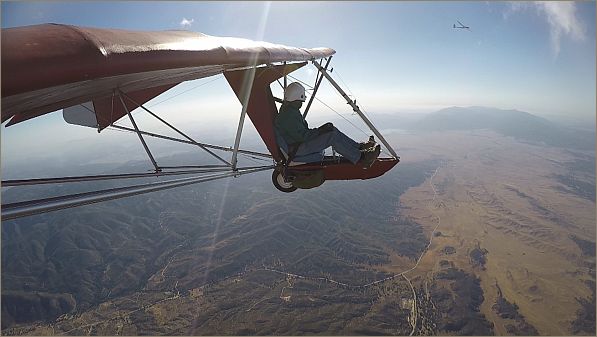
|
This
looks like that 10,000 foot spot, following the sailpane
around at cloud base. The airport Floyd is flying
towards
(26.4 miles from launch) is off to the right of the lake bed plain, maybe not visible here. |
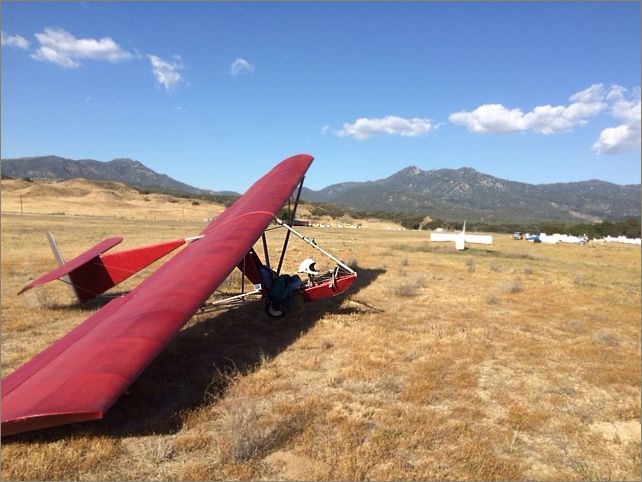
|
A
comfortable landing at the local gliderport at Warner Springs,
with Hot Springs Mountain in the background.
He probably landed from that direction, I think the wind indicator, that white pseudo-sailplane, is pointing toward the camera. On the ground, it's common practice to turn the glider three quarters or so into the wind so it is stable and will stay put. No doubt the truck is on the way so the glider can be carried home on cartop. |
